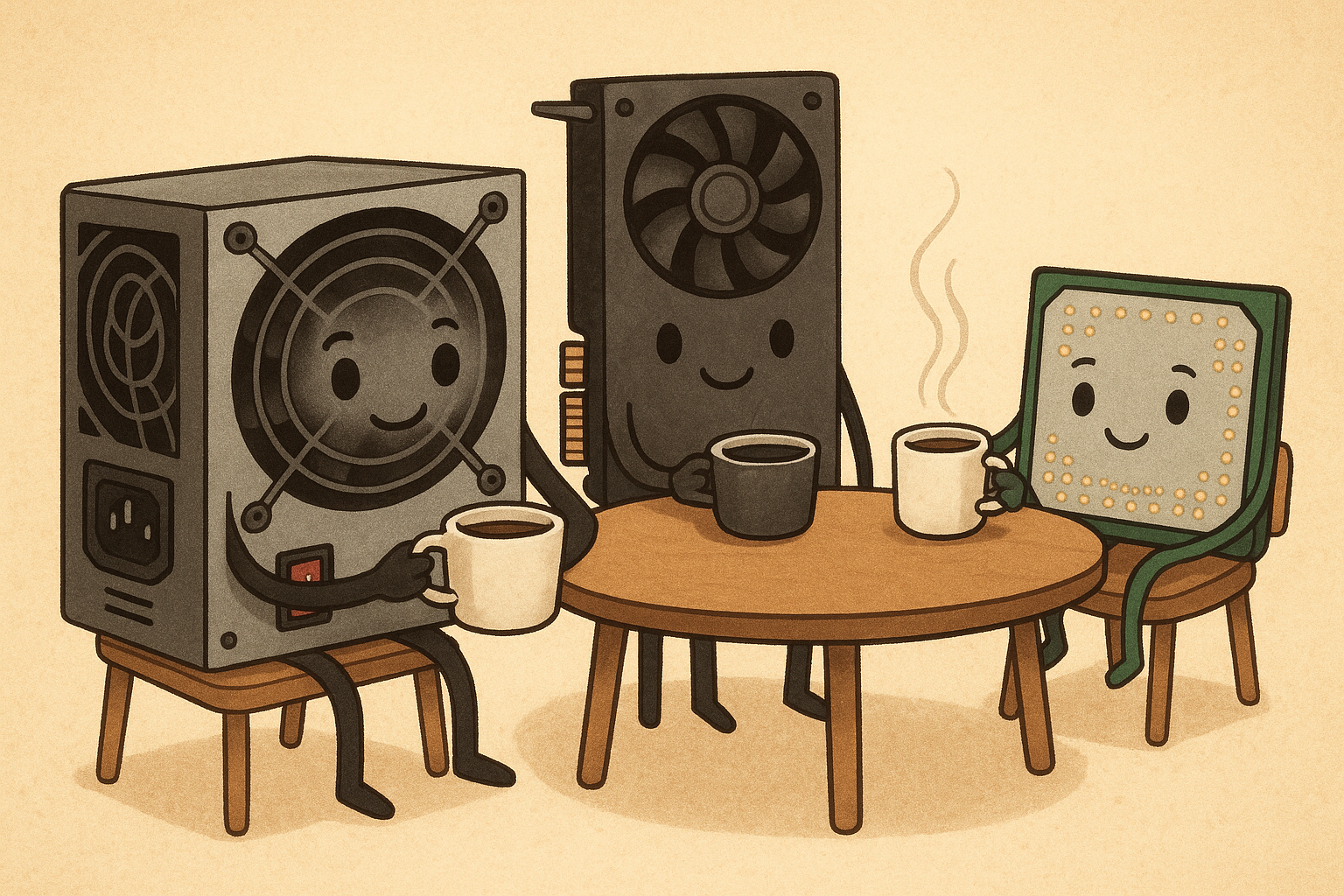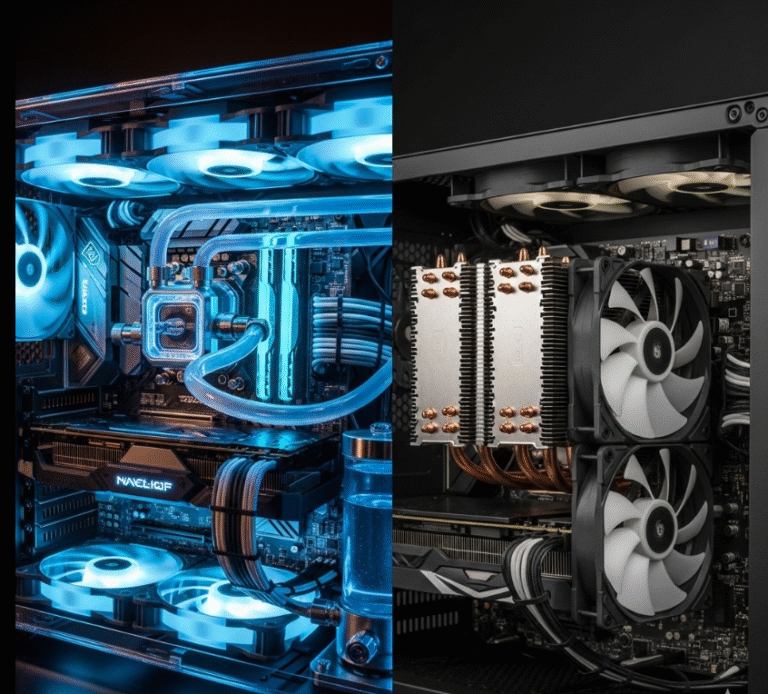Let’s begin with a story from the good old times of computing. In the past, as the world was dominated by beige towers and CRT monitors, your run-of-the-mill PC required little to kick-start. Insert a power supply the size of a toaster that had the output of a glorified microwave and—voila!—you had a functional computer in your hands. These were the times, my friend, when a 250-watt PSU would boot up your CPU, RAM, hard disk, and even your floppy disk drive effortlessly.
Fast forward to today, and powering a modern gaming rig or workstation is more like fueling a small electric vehicle. You wouldn’t try to charge a Tesla with a hamster running in a wheel, would you? No? Well, that’s kind of what happens when you try to run a modern PC on a power supply that’s too weak for the job. So let’s dive deep—why PSU wattage suddenly matters more than ever, and why our PCs from the 90s didn’t give a silicon-fueled hoot.
The Early Days: When 200 Watts Was Sufficient
In the 90s and early 2000s, computers were, by today’s standards, laughably underpowered. CPUs had single cores at speeds that would today be deemed criminally sluggish. GPUs—if you even had one at all—were little more than glorified calculators that assisted your computer in drawing windows and icons slightly more quickly.
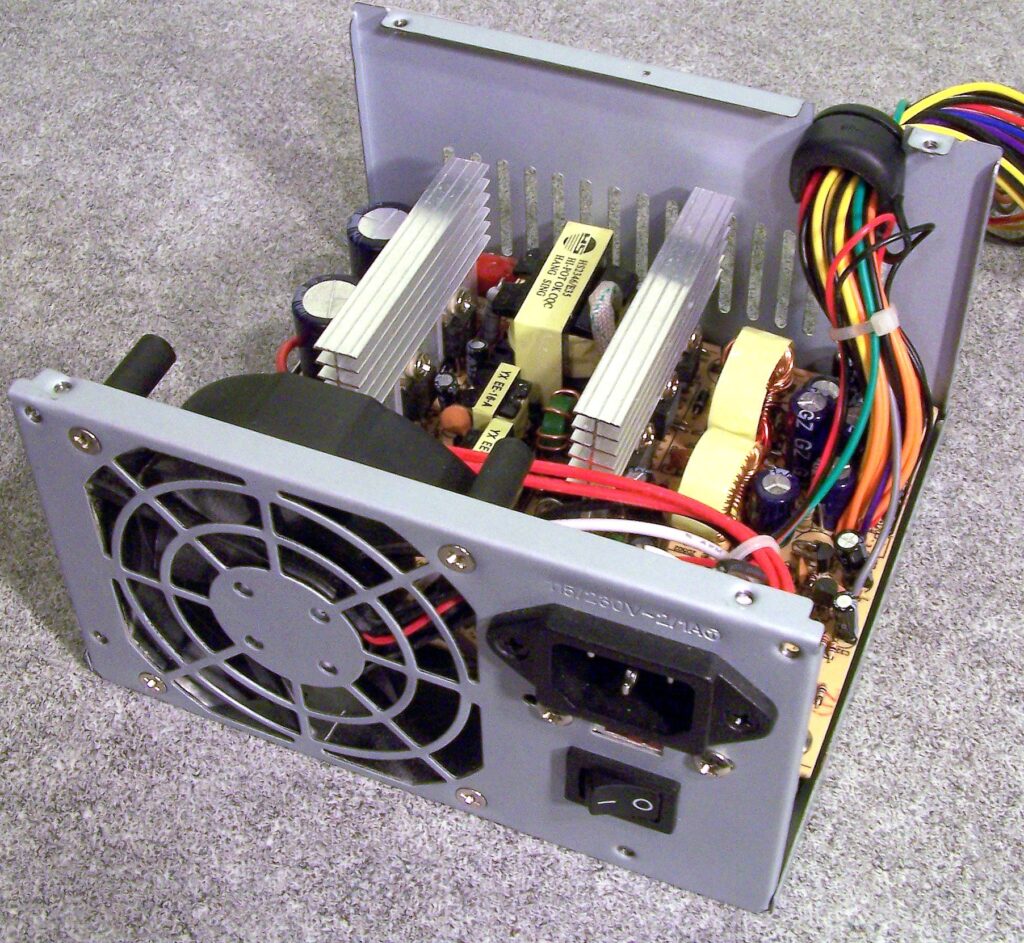
They were intended for everyday computing use: word processing, casual gaming, dial-up browsing of the internet, and likely playing a few CD-ROMs. Such activities required little oomph. An Intel Pentium III system with a 20GB hard disk, 128MB of RAM, and a GeForce 2 video card would operate from a 250-300W PSU with no trouble at all.
Also, periphery hunger was minimal. No RGB lighting strips, no multi-GPUs, no 360mm liquid cooling, and no M.2 drives for dedicated voltage rails. Your power draw was mild and predictable, like a grandpa having a cup of tea in the middle of the week’s afternoon.
Enter the Modern Era: Power-Hungry and Proud
Modern computers are a different beast altogether. They’re juiced up on silicon hormones, chugging along at clock speeds and voltages that would’ve given a 90s machine a cardiac arrest. Why PSU wattage matters more than ever:
1. Graphics Cards: The Real Guzzlers
Let’s not fool ourselves—GPUs are the single largest user of power in contemporary systems. A high-end NVIDIA RTX 5090? That sucker can draw up to 600 watts by itself at full tilt. That’s twice as much as a whole computer from the year 2001 drew.
And if you’re going for SLI (if you’re somehow stuck in 2015) or even just a high-performance workstation GPU like the NVIDIA RTX A6000, you’re entering power draw territory that starts to rival small household appliances.
2. CPUs Aren’t Saints Either
Modern CPUs, especially those from Intel’s high-performance series or AMD’s Threadrippers, can consume 125W to 300W or more. Add overclocking into the mix, and you’re practically running a space heater.
Old processors? They were 50-70W TDP and didn’t even have turbo boost. They weren’t gaming at 240Hz at the same time they were compiling code and twitch-streaming. They were only looking at surviving long enough to get past the loading screen of Solitaire.
3. Storage and RAM Multiply Like Rabbits
In the old days, a solo hard drive was sufficient. Nowadays, we’ve got NVMe drives, SSDs, and backup HDDs. They all take a little bit of current, and it adds up. Ram was a pair of sticks of 512MB in the old days. Nowadays, 64GB of high-performance DDR5 RAM, oftentimes sporting RGB lighting (why not?), can take more than you’d think.
4. Accessories, Bling, and Cooling
Do not forget the RGB fans, LED strips, fan controllers, PCIe add-in cards, AIO pumps, USB hubs, and the rare external toaster masquerading as a peripheral.
Contemporary systems tend to look like a rave’s lighting show, and all of those bright lights? They’re not fueled by your good looks—it consumes current, pal. Want six RGB fans and a triple-fan GPU? You’d better be certain your PSU can support it without toppling like a soggy cardboard box.
5. Efficiency and Headroom
Here’s the dirty truth: your PSU is deceiving you. Well, sort of.
If you’re buying a 850W PSU, that doesn’t mean you’re going to be running it at 849W at all times. PSUs are at their best at 50-70% utilization. It’s efficiency. The majority of PSUs are less efficient at maximum utilization, hotter, and subject to failure down the line. If your system can only go up to 700W, buying a 750W PSU will be of no use to you. You should be looking at at least a 850W, preferably 1000W if you’d like to have some cushion.
Plus, there’s the little issue of aging. As PSUs get older, their capacitors degrade, and they supply less stable power. If you skimped on wattage in the first place, you might find yourself crashing mid-game or worse—smelling the unmistakable scent of “burnt electronics and regret.”
Why More Wattage = More Stability
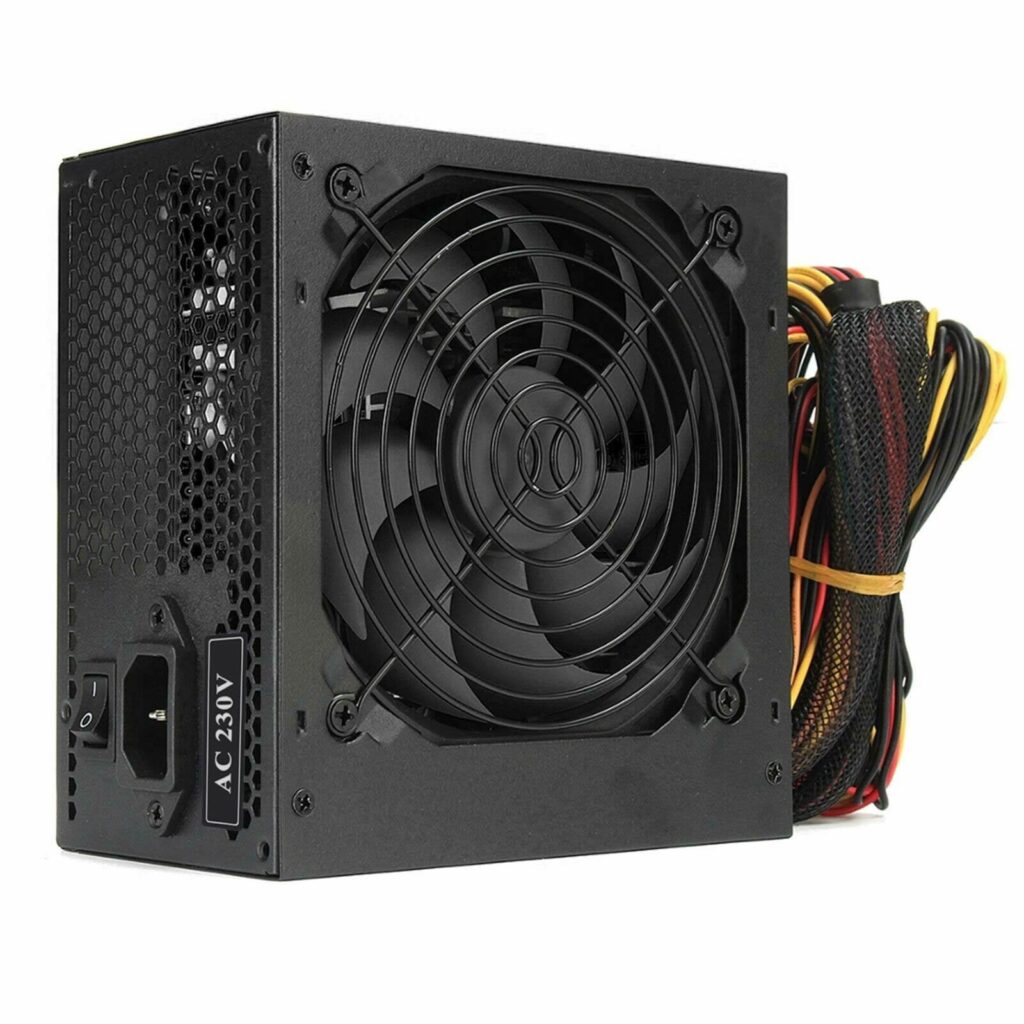
Even if your system does not always take in its maximum rated power, you want a PSU that can easily deliver when it must. Spikes occur—at game loading, video playback, or even heavy multitasking.
A good PSU is akin to a club bouncer: it may simply loom menacingly much of the time, but if trouble starts brewing, you want it to be able to get physical.
Why It Didn’t Matter Before: Simplicity
In short, it was simpler, less demanding, and not always maxxing out the power consumption. You didn’t require a high-watt PSU since you didn’t have high-power components. They weren’t mid-tower supercomputers trying to do everything. They were content to open up Clippy in Microsoft Word and potentially run Minesweeper.
Today’s systems are more like mini data centers, especially for gamers, content creators, and professionals. You’re running high-core CPUs, monster GPUs, advanced cooling, and lighting setups that make your PC look like it’s trying to lift off.
PSU Myths (Let’s Bust a Few)
“More watts = better.”
Not exactly. You want enough wattage, not too much. Buying a 1600W PSU for a 400W build is like putting a semi-truck engine in a lawnmower—it might technically work, but it’s inefficient, expensive, and ridiculous.
“Cheap PSUs are fine if they say 850W.”
Run. Run far away. Cheap PSUs often lie about their wattage. A no-name brand claiming 850W might only reliably deliver 500W—and not cleanly. Bad power delivery means voltage spikes, crashes, and possibly frying your components. Stick to reputable brands with 80+ certification (Bronze, Silver, Gold, or better).
So How Much Do You Need?
Quick ballpark:
- Basic Office PC: 300W–400W
- Mid-Range Gaming Rig (single GPU, i5/R5 class): 600W–750W
- High-End Gaming/Workstation: 850W–1000W
- Dual GPU or Heavy Overclocking: 1200W
You should always leave yourself 20–30% headroom, since noone wants a PSU operating at the limits of a nervous crisis.
Don’t Be the Guy Who Cheaped Out
In today’s world of flashy hardware and high-performance everything, PSU wattage is no longer just a number—it’s a foundational part of a stable, safe, and future-proof PC.
So the next time you’re deciding how to allocate funds for the next build and you’re stuck between a high-wattage power supply and a few more RGB fans, remember: dead GPUs don’t glow. Don’t be the man who invests $2,500 in parts and plugs it into a dusty 500W 2010 power supply sitting in a drawer named “Misc.” Give your computer the power it’s worth. Because while love may be the power of life, in the computing world, it’s all about the watts.
🔌 PSU Efficiency Ratings Explained (80 Plus Guide)
💡 Why it matters:
A PSU’s efficiency rating tells you how well it converts electricity from your wall (AC) into usable power for your PC components (DC). Higher efficiency = less wasted heat, quieter operation, and lower electric bills.
🎯 Efficiency Ratings Breakdown
| Rating | Efficiency at 50% Load | Good For |
|---|---|---|
| 80 Plus (Base) | ≥ 80% | Entry-level/budget builds |
| 80 Plus Bronze | ~82–85% | Basic gaming or office PCs |
| 80 Plus Silver | ~85–88% | Mid-tier builds (rare now) |
| 80 Plus Gold | ~87–90% | Ideal balance for most gamers |
| 80 Plus Platinum | ~90–92% | Workstations, overclocked setups |
| 80 Plus Titanium | ~94%+ | Enterprise servers, mining rigs |
🛠️ Quick Tips:
- Gold is the sweet spot for most gaming or productivity builds.
- A higher rating means less heat, longer PSU lifespan, and better stability.
- Avoid sketchy no-name brands that claim high wattage with no 80 Plus rating—those are PSU-shaped time bombs.
What Do You Recommend?
While Gold, Platinum, and Titanium rated Power Supply Units may sound expensive, it’s not as bad as you may think (if you want to make a quality build, at least). Below are some of the best choices to power your new gaming system from brands that offer extensive warranties (10 years on MSI!) and names you already know!
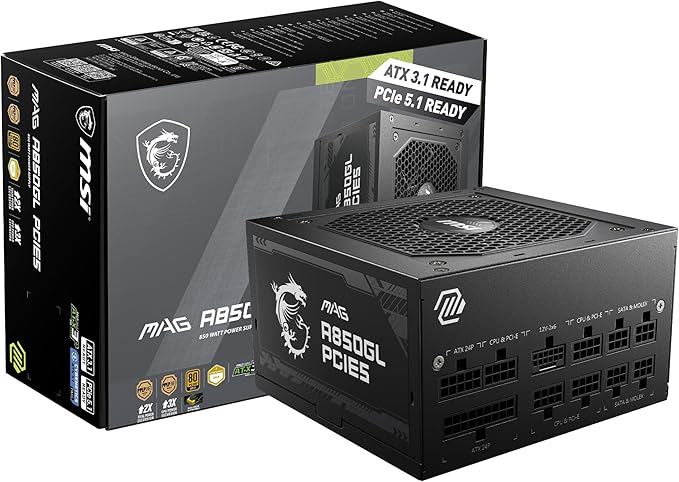
MSI MPG A850GL is your new best friend. With 850 watts of fully modular, 80+ Gold certified
Looking for rock-solid, future-proof power for your high-performance gaming rig? This PSU delivers efficient, stable power to even the hungriest GPUs like the RTX 4090—without breaking a sweat.
Top Features:
- ✅ 80+ Gold Certified Efficiency – Lower heat, less noise, more savingsz on your electric bill.
- ✅ Fully Modular Design – Use only the cables you need for a cleaner, more airflow-friendly build.
- ✅ ATX 3.0 & PCIe 5.0 Ready – Future-proof your rig with native support for next-gen GPUs and power spikes.
- ✅ Compact Form Factor – Fits in most cases with room to spare at just 140mm deep.
- ✅ Zero Frozr Fan Mode – Whisper-quiet under light load, cooling power when it counts.
Whether you’re overclocking, streaming, or just fragging all night long, the A850GL has your back with premium Japanese capacitors, industrial-grade protection circuits, and MSI’s legendary build quality.
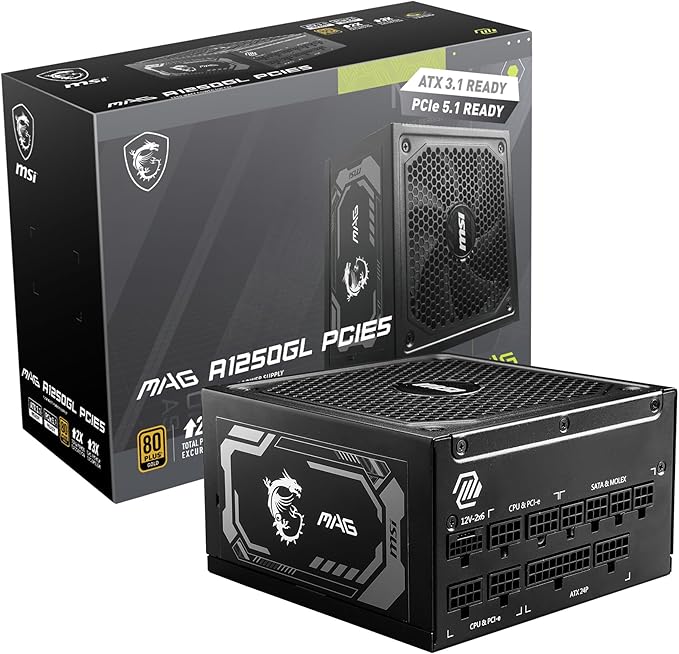
MSI MAG 1250GL PCIE 5 1250W Power Supply – Unmatched Power, Ready for Anything
Ready to build a monster PC without worrying about running out of power? The MSI MAG 1250GL PCIE 5 has you covered. With 1250 watts of fully modular, 80+ Gold certified performance and ATX 3.1 + PCIe 5.1 readiness, this PSU is built to handle next-gen GPUs and power-hungry CPUs with aplomb.
Top Features:
- ✅ 10-Year Warranty & Industrial Protections – Includes OVP, OCP, OPP, OTP, SCP, UVP, and active PFC for total peace of mind .
- ✅ 80+ Gold Efficiency & Cybenetics Gold-certified – Up to ~91% efficient, keeping heat, noise, and electricity bills in check .
- ✅ ATX 3.1 / PCIe 5.1 Compliant – Supports dual power excursions and 3× GPU spikes; ready for RTX 40/50 series and beyond .
- ✅ Native Dual-Color 12V‑2×6 Connector – Instantly see when your GPU cable is fully seated—no guesswork .
- ✅ Compact 150 mm Depth Full Modular Design – Space-saving, airflow-friendly, and mess-free builds .
- ✅ 135 mm FDB Fan with Cybenetics Standard+ Noise – Cool operation and decent acoustics, with proven peak reliability (2500W excursion without shutdown) .
If you’re building a flagship-grade system—think overclocked CPU, multi-slot PCIe 5 GPU, loads of storage, and aggressive lighting—the MSI MAG 1250GL PCIE 5 1250 W PSU delivers premium power efficiency, clean cable management, future-proof compliance, and rock-solid reliability.
Links to Amazon products may bring in a small commission to the website. This is not a price increase for you!

